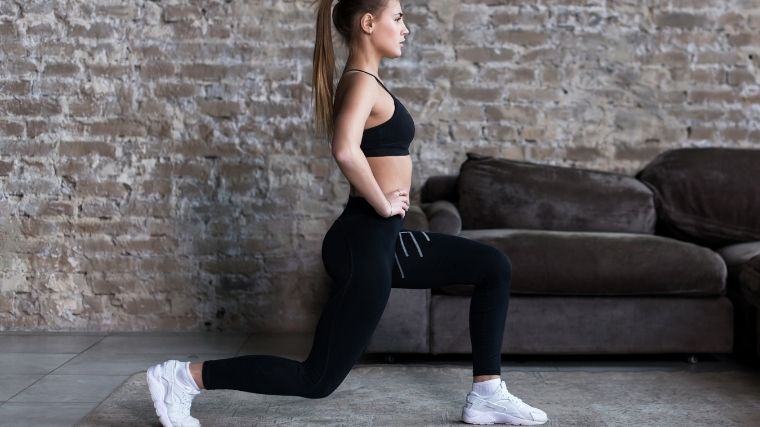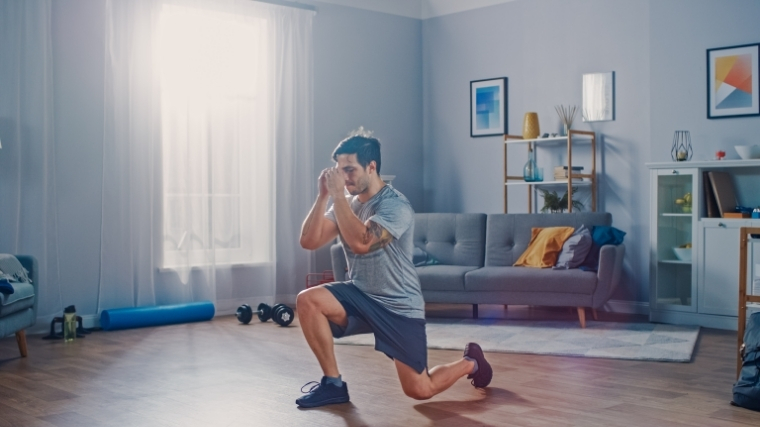Squats are widely considered the king of all leg exercises, but the lunge is — or should be — a close second. Done correctly, lunges are an efficient leg blaster, helping bodybuilders grow their wheels with ease. Several studies have also shown they’re great for building strength in muscles such as the hamstrings and calves. (1) As far as movement is concerned, the one-leg-at-a-time nature of the lunge mobilizes the joints and enhances balance, coordination, and proprioception. So athletes will find them as useful as a bodybuilder trying to get as big as possible.
Beyond their gym applications, lunges also help build the muscles we use to do everything from walking to sitting up and down. So if you’re not already doing them, there’s no reason why you shouldn’t. This article will go over five benefits of the lunge and give some tips on how to perform and program them.
Lunge Benefits
- Improved Balance and Coordination
- Greater Glute Activation
- Better Muscular Symmetry
- Enhanced Muscle Growth
- Minimized Injury Risk
Editor’s note: The content on BarBend is meant to be informative in nature, but it shouldn’t take the place of advice and/or supervision from a medical professional. The opinions and articles on this site are not intended for use as diagnosis, prevention, and/or treatment of health problems. Speak with your physician if you have any concerns.
Improved Balance and Coordination
Lunges require a lifter to support themselves primarily on one leg (the other leg may or may not be used for assistance). The need for joint stability and control (in the ankle, knee, and hips) heightens this movement’s difficulty, increasing the neurological and muscular demands.
Seeing that many human movement patterns and fixed positions (such as the squat) rely heavily on both, increasing balance and coordination can lead to greater single-leg performance (jogging, sprinting, jumping, formal sports, etc.). Those benefits will also transfer over to your bilateral strength output, such as increasing your squat or even your jumping power. (2)

Greater Glute Activation
Lunges address weaknesses in balance and coordination, as well as demanding dormant muscle groups to develop. The glutes are a powerful muscle group that can be targeted (especially in wide stance lunges), leading to enhancements in power output, decreased lower back pain, running economy, and speed.
By lunging, as well as performing hip bridges and Romanian deadlifts, we can specifically target the glutes to increase muscle firing and activation rates, increase hypertrophy, and positively impact sports performance.
Read More: Best Glutes Exercises
Better Muscular Symmetry
Correcting muscular imbalances is important to the minimization of injury in athletes and fitness buffs alike. Chances are, many of you have movement and muscular asymmetries that go unnoticed or unaddressed due to the great amounts of bilateral (two limbs at once) movements we do in our training.
While bilateral movements are highly beneficial, employing lunges and other unilateral exercises can increase muscular hypertrophy and strength in a weaker leg, diminishing movement and developmental asymmetries and compensation patterning.
Enhanced Muscle Growth
Unilateral training has been shown to increase muscle activation, which can lead to more forceful muscular contractions. One leg carries more of your bodyweight by performing lunges than it would during a bilateral squat. This is beneficial when trying to focus on the development of specific muscle groups. (3)

[Read More: Best Upper Chest Exercises for Building Muscle]
The ability to make the mind-to-muscle connection via unilateral training is highly beneficial to adding quality lean mass and sound movement mechanics, which can impact squat strength and health, sports performance, and overall leg development.
Minimize Injury Risk
To be clear, lunges don’t prevent injuries. However, they do strengthen the muscles — both big and small — that improve your ability to stabilize under a heavy load. By this logic, a more efficient lunger will have better coordination and ankle, knee, and hip joint strength. That means they’ll be better able to control the load of a heavy back squat or deadlift. Therefore, the lifter is technically safer. No move can “bulletproof” your body, but it can enable you to be safer as you lift.
How to Do the Lunge
Here’s how to perform the perfect lunge.
- Grab a pair of dumbbells (or kettlebells) with a neutral grip (palms facing each other).
- Stand shoulder-width apart with the arms fully extended at your sides.
- Take a large step forward with one leg, lowering your rear knee toward the ground while keeping your front shin vertical while keeping your torso upright.
- Push with your front leg back to the starting position.
- Repeat with the opposite leg.
Switch it Up
The dumbbell lunge is one of the most popular variations, but there are ways to spice it up. This move can easily be done with just your bodyweight. For an extra challenge, increase the reps or try lowering yourself to the ground at a slow pace.
For advanced lifters, try performing the lunge with a barbell across your traps. Start with an empty bar before attempting to add weight to it, and if you find yourself struggling at any point, lower the weight.
[Read More: The Best Ab Exercises & Workouts, According to a CPT]
The goblet lunge is performed exactly like the regular lunge, but with a kettlebell held at chest-height. Doing this is great practice for keeping your torso upright during the move.
Muscles Worked by the Lunge
No surprise here, but the lunge is a leg move and should be performed during leg day. Specifically, it works the abdominals, glutes, quadriceps, hamstrings, and calves.
A study published in the Journal of Strength and Conditioning Research found that while squats were better for muscle activation, lunges offered more comfort for people with knee problems. The same study found people recovering from any leg injury could benefit from incorporating lunges into their rehabilitation routine. (4)
Lunge Programming Suggestions
As this is a lunge move, you’ll want to perform the lunges any day you hit your lower half. If you’re going to perform squats on those days, then make lunges your second move — this will give you enough strength to ensure you’re doing them properly while still saving energy for other accessory moves.
[Read More: The Best Bodyweight Exercises, + Workouts and Tips From a CPT]
If you’re foregoing the squat, start with this move and use heavier weights than you would if doing them second. For strength, aim for four sets of six to eight reps per leg.
Lunges are, primarily, a hypertrophy move, so stick with lighter weight and more reps. Aim for 12-15 reps per leg for three to four sets if you’re using any weight. If you’re doing them with just bodyweight, go for 15-20 per leg.
FAQs
What are the benefits of doing the lunge?
- Improved Balance and Coordination.
- Greater Glute Activation.
- Better Muscular Symmetry.
- Enhanced Muscle Growth.
- Minimized Injury Risk.
How many sets an reps of the lunge should I do?
It depends on your goal.
For more muscle, do 12-15 reps per leg for three to four sets if you’re using any weight. If you’re doing them with just bodyweight, go for 15-20 per leg.
For strength, do six to eight reps per leg for four sets. Use a moderate load. You don’t want to max these out.
At what point in my workout should I do lunges?
Early on. The lunge is a compound movement — meaning that it involves more than one joint — and is pretty taxing on the lower body. If you’re doing squats, then do the lunges after that using the muscle growth set and rep scheme above. If you’re doing leg day without squats, the lunge can be your first movement. Use the strength set and rep scheme above.
More Lunge Content
Yeah, the lunge is so important and beneficial that we’ve penned more than one article on it. Now that you’re aware of lunge benefits, here are two other lunge-centric pieces from BarBend worth reading.
- Lunges vs. Squats — Which Is Best for Strength?
- The Beauty of Lunge Variations and How to Reap All of Their Benefits
References
- Jönhagen S, Ackermann P, Saartok T. Forward lunge: a training study of eccentric exercises of the lower limbs. J Strength Cond Res. 2009 May;23(3):972-8. doi: 10.1519/JSC.0b013e3181a00d98. PMID: 19387378.
- Khaiyat OA, Norris J. Electromyographic activity of selected trunk, core, and thigh muscles in commonly used exercises for ACL rehabilitation. J Phys Ther Sci. 2018;30(4):642-648. doi:10.1589/jpts.30.642
- Eliassen W, Saeterbakken AH, van den Tillaar R. COMPARISON OF BILATERAL AND UNILATERAL SQUAT EXERCISES ON BARBELL KINEMATICS AND MUSCLE ACTIVATION. Int J Sports Phys Ther. 2018;13(5):871-881.
- Irish, Sian E; Millward, Adam J; Wride, James; Haas, Bernhard M; Shum, Gary LK The Effect of Closed-Kinetic Chain Exercises and Open-Kinetic Chain Exercise on the Muscle Activity of Vastus Medialis Oblique and Vastus Lateralis, Journal of Strength and Conditioning Research: May 2010 – Volume 24 – Issue 5 – p 1256-1262 doi: 10.1519/JSC.0b013e3181cf749f
Featured image: Undrey/Shutterstock